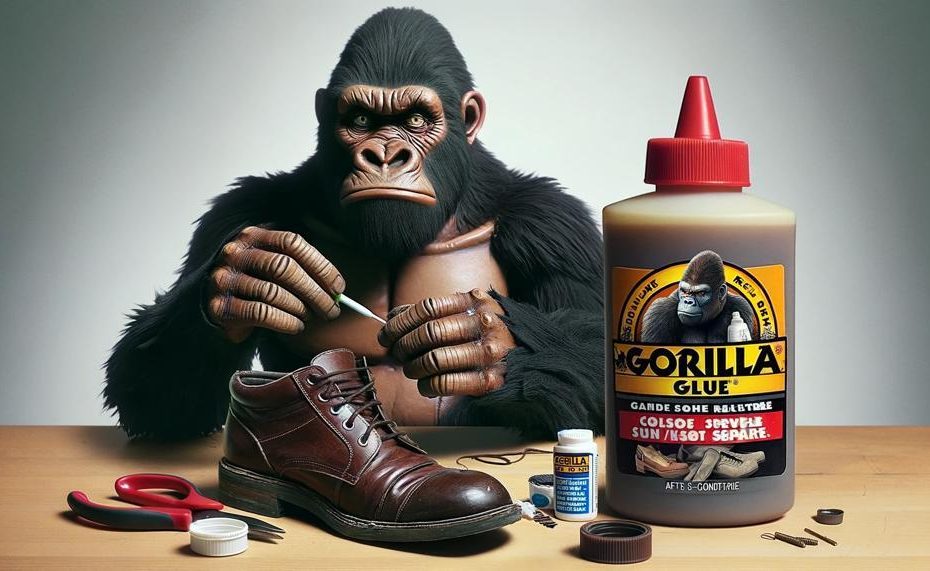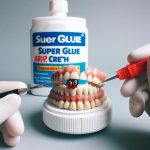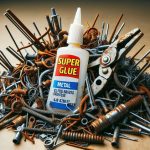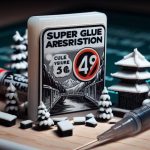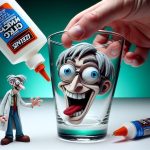Are you tired of constantly having to replace your worn-out shoes? Do you wish there was a quick and easy solution to prolong the life of your favorite kicks?
Yes, that’s right. The same powerful adhesive known for its strength and durability in household repairs can also work wonders on your shoes. Many people have successfully used Gorilla Glue to fix everything from loose soles to broken straps on their footwear.
So, can I use gorilla glue to fix my shoes?
Yes, you can use Gorilla Glue to fix shoes. Gorilla Glue is a polyurethane adhesive that can be used on a variety of materials, including rubber, leather, stone, metal, wood, glass, and ceramic. It’s also waterproof and can cure in 24 hours.
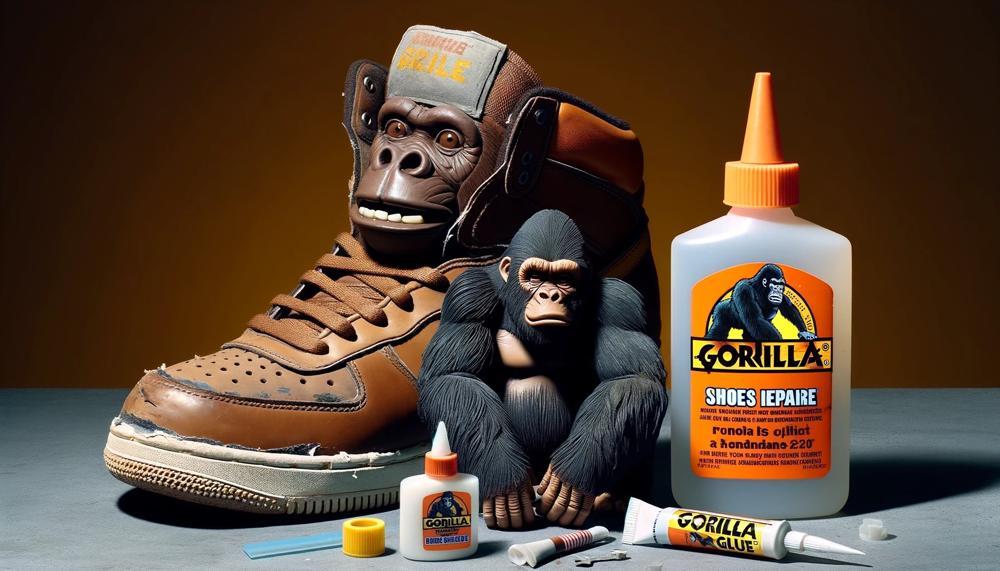
So next time you’re faced with a shoe repair dilemma, consider giving Gorilla Glue a chance. Not only could it save you time and money in the long run, but it could also keep your beloved shoes in top shape.
Table of Contents
- 1 Benefits of Using Gorilla Glue for Shoe Repairs
- 2 Types of Shoes That Gorilla Glue Is Suitable for
- 3 Tips for Preparing the Shoes Before Applying Gorilla Glue
- 4 Common Mistakes to Avoid When Using Gorilla Glue for Shoe Repairs
- 5 Alternative Shoe Repair Options to Consider
- 6 Factors to Consider Before Attempting Shoe Repairs with Gorilla Glue
- 7 Advice for Maintaining and Extending the Lifespan of Repaired Shoes
- 8 Conclusion
Benefits of Using Gorilla Glue for Shoe Repairs
When it comes to repairing shoes, Gorilla Glue offers numerous benefits compared to other types of glue. Its strength, versatility, and durability make it a top choice for shoe repairs.
| Advantage | Description |
| Strength | Gorilla Glue is renowned for its robust bonding capabilities, making it the perfect option for fixing shoes made of hard materials such as boots. |
| Versatility | Unlike other shoe glues that only work on specific shoe types, Gorilla Glue can bond to almost any material, including suede, leather, and rubber. |
| Durability | Gorilla Glue is resistant to extreme temperatures and moisture, making it ideal for repairing shoes that will be exposed to tough conditions. |
Apart from these advantages, Gorilla Glue also boasts a fast drying time and a clear finish, ensuring virtually invisible repairs. Its affordability also makes it a top choice among hikers, backpackers, and runners who may need to quickly fix their shoes while on the go.
While other shoe repair glues like Shoe Goo also offer flexibility and durability, they may not be as sturdy as Gorilla Glue when bonding hard materials. However, Shoe Goo’s flexible formula makes it a better option for fixing broken soles or more delicate shoes like sneakers.
Types of Shoes That Gorilla Glue Is Suitable for
| Boots and Shoes for Hiking | Gorilla Glue is a popular choice for repairing boots and shoes used for hiking due to its durability and resilience to tough outdoor conditions. It can bond with a variety of materials commonly found in hiking footwear, such as leather, rubber, and fabric. | Example: A hiker can use Gorilla Glue to fix a detached sole or a torn upper material on their hiking boots, ensuring they can continue their journey without interruption. |
| Shoes for Running | Gorilla Glue is an ideal option for repairing running shoes, as it can withstand the constant movement and impact that comes with running. It works well on materials commonly used in running shoes, such as mesh, rubber, and foam. | Example: A runner can use Gorilla Glue to mend a separated sole or a torn mesh on their running shoes, allowing them to continue their daily exercise routine without any setbacks. |
| Casual Shoes | Gorilla Glue is also suitable for repairing casual shoes, including sneakers, loafers, and boat shoes. Its strong bonding properties make it perfect for everyday wear and tear on various materials like canvas, leather, and rubber. | Example: A person can use Gorilla Glue to fix a loose sole or a broken strap on their favorite pair of canvas sneakers, ensuring they can continue to wear them comfortably for everyday activities. |
| Work Boots | Gorilla Glue is an excellent choice for repairing work boots due to its strong bonding capabilities and ability to withstand harsh working conditions. It can bond with materials commonly used in work boots, such as leather, rubber, and steel. | Example: A construction worker can use Gorilla Glue to repair a cracked sole or a torn leather upper on their work boots, ensuring they can continue to work safely and comfortably. |
| Outdoor Sandals | Gorilla Glue is also suitable for repairing outdoor sandals, such as hiking sandals and water shoes. It can handle wet and rugged conditions and bond with materials commonly used in outdoor sandals, such as rubber, nylon, and leather. | Example: A person can use Gorilla Glue to mend a detached strap or a torn sole on their hiking sandals, ensuring they can continue to enjoy their outdoor activities without any interruptions. |
Tips for Preparing the Shoes Before Applying Gorilla Glue
Before fixing shoes with Gorilla Glue, it’s crucial to properly prepare the surfaces. This ensures a strong and long-lasting bond that can withstand everyday wear and tear. Follow these important steps for preparing shoes before applying Gorilla Glue:
| Step 1: | Thoroughly Clean the Area | Use a mild soap and warm water to clean the area that needs repair. This removes any dirt, oils, or debris that may prevent the glue from adhering effectively. |
| Step 2: | Roughen the Surfaces | Lightly roughen the surfaces that will be glued together using sandpaper or a rough cloth. This creates a better bonding surface for the glue to stick to. |
| Step 3: | Apply the Right Amount of Glue | Start with a small amount of Gorilla Glue and add more if necessary. It’s better to start with less and add more than use too much, causing it to squeeze out of the repair area. |
| Step 4: | Evenly Apply the Glue | Use a brush or applicator to evenly spread the glue on the surface. Be sure to cover the entire area that needs repair. |
| Step 5: | Apply Pressure | To ensure a strong bond, use clamps or heavy objects to apply pressure on the repaired area while the glue dries. This helps the surfaces stick together and create a solid bond. |
| Step 6: | Allow it to Dry Completely | Gorilla Glue takes at least 24 hours to fully cure. It’s important to let it dry completely before wearing the shoes to ensure a strong bond. |
| Step 7: | Protect Surrounding Areas | To prevent excess glue from getting on other parts of the shoe, use masking tape or painter’s tape to cover surrounding areas. This also keeps the repair area clean and tidy. |
| Step 8: | Reinforce with Sealant | After the glue has cured, consider using a sealant like Shoe Goo to reinforce the bond and protect it from moisture and wear. This makes the repair even stronger and more durable. |
| Step 9: | Avoid Water Exposure | To maintain the durability of the repair, it’s best to avoid exposing the shoes to water whenever possible. This helps prevent the glue from breaking down and weakening the bond. |
Common Mistakes to Avoid When Using Gorilla Glue for Shoe Repairs
| Common Mistakes to Avoid When Using Gorilla Glue for Shoe Repairs | Why it is Important to Avoid These Mistakes | Tips to Prevent These Mistakes |
| Choosing the wrong type of Gorilla Glue | The standard version of Gorilla Glue is not suitable for shoe repairs and can result in a weak and unsightly bond. The Clear Grip Waterproof Contact Adhesive is specifically designed for shoe repairs and provides a stronger and more flexible bond. | Always check the label and choose the correct type of Gorilla Glue for your shoe repair needs. The Clear Grip adhesive is your best bet for a successful repair. |
| Applying too much glue | Excess glue can create a messy and uneven repair, affecting the flexibility and comfort of the shoe. It can also add bulkiness to the repaired area. | Less is more when it comes to using Gorilla Glue. Use a small amount and add more if needed, rather than dealing with excess glue. |
| Not properly preparing the surfaces | A clean and dry surface is crucial for a strong bond. If the surfaces are not prepared correctly, the repair may not hold up over time. | Thoroughly clean and dry the surfaces before applying Gorilla Glue. This will ensure a strong and long-lasting bond on your shoes. |
| Not giving enough drying time | Gorilla Glue requires at least 24 hours to fully dry and cure. Rushing this process can result in a weak bond that will not hold up over time. | Be patient and give the glue enough time to dry and cure. This will ensure a strong and durable bond on your shoes. |
| Using it on unsuitable materials | Gorilla Glue is not suitable for all materials, such as smooth or non-porous surfaces. Using it on these materials can result in a weak bond that will not last long. | Always check the label and make sure to use Gorilla Glue only on suitable materials for shoe repairs. For smooth or non-porous materials, Shoe Goo may be a better option for a stronger and more flexible bond. |
By avoiding these common mistakes, you can ensure a successful and long-lasting repair on your shoes using Gorilla Glue. It is important to carefully follow the instructions on the label and use the glue in a well-ventilated area.
Alternative Shoe Repair Options to Consider
When it comes to repairing shoes, there are several alternative options to consider instead of using Gorilla Glue. Each option has its unique properties and benefits that cater to different types of shoes and levels of damage.
Some popular alternatives include Shoe Goo, Loctite Flextec, and Super Glue.
Shoe Goo
For those looking for a clear adhesive suitable for all types of shoes, Shoe Goo is a top choice. Its flexibility when dried makes it perfect for repairing heels and soles.
It also boasts a strong bond that can withstand temperature changes and water exposure.
Loctite Flextec
Specifically formulated for repairing flexible materials like shoes, Loctite’s Flextec offers a strong bond that can withstand various environmental conditions.
This makes it ideal for repairing rubber or leather shoes.
Super Glue
Another fast-drying adhesive that can be used as an alternative for shoe repair is Super Glue.
While it offers quick bonding capabilities, it is not recommended for use on rubber or plastic materials as it can cause them to harden and become brittle.
Other Adhesive Brands
Aside from the mentioned options, there are also other adhesive brands specifically designed for shoe repairs, such as Barge All-Purpose Cement and E6000 Craft Adhesive.
These adhesives provide strong bonds and can withstand various environmental conditions.
Ultimately, the choice between these alternatives depends on personal preference and the specific needs of the damaged shoe. Factors to consider include the type of shoe being repaired, the extent of damage, and the environmental conditions it will be exposed to.
Factors to Consider Before Attempting Shoe Repairs with Gorilla Glue
Before embarking on shoe repairs using Gorilla Glue, there are several crucial aspects to keep in mind to achieve the best and most durable results.
These factors include compatibility, surface preparation, proper application, drying time, testing, limitations, and safety precautions.
| Factors to Consider Before Attempting Shoe Repairs with Gorilla Glue | Details | Importance |
| Compatibility | Check if Gorilla Glue is suitable for the material of your shoes. | Using an incompatible adhesive can result in weak bonds or damage to the shoe. |
| Surface Preparation | Ensure the shoe surface is clean and dry before applying the glue. | A clean and dry surface allows for optimal bonding strength. |
| Proper Application | Apply a thin and even layer of glue, avoiding excessive amounts. | Excessive glue can lead to messy outcomes and weak bonds. |
| Drying Time | Allow sufficient time for the glue to dry and cure. | Rushing the process can result in a weaker bond. |
| Testing | Conduct a small test on a less visible area of your shoes before committing to using Gorilla Glue on the entire shoe. | This ensures that the glue works well and does not cause any damage to the shoe. |
| Limitations | Keep in mind that Gorilla Glue may not work well on certain materials or withstand excessive wear and tear over time. | Using Gorilla Glue on unsuitable materials can result in weak bonds or damage to the shoe. |
| Safety Precautions | Work in a well-ventilated area, wear protective gear, and handle spills carefully when using Gorilla Glue. | Ensuring safety is important when working with any adhesive. |
By taking into consideration these key factors before attempting shoe repairs with Gorilla Glue, you can ensure a successful and long-lasting outcome. It is also essential to keep in mind that there are other adhesive options available, and the best choice depends on personal preference and the specific needs of the damaged shoe.
Advice for Maintaining and Extending the Lifespan of Repaired Shoes
| Advice for Maintaining and Extending the Lifespan of Repaired Shoes | It is important to take proper care of your repaired shoes to ensure they last as long as possible. By following these tips, you can extend the lifespan of your shoes and keep them looking their best. |
| Regularly Polish Leather Footwear | To keep your leather shoes looking shiny and new, it is recommended to regularly polish them. A high-quality shoe polish and soft cloth will not only repel dirt and protect the shoe, but also maintain its appearance. |
| Use Protective Spray and Brush for Suede Shoes | Suede shoes require special care to maintain their appearance. Protect them from stains and water damage by using a suede-specific protective spray. Use a suede brush to remove dirt and maintain the texture of the material. |
| Proper Storage | The way you store your shoes can also impact their lifespan. To avoid damage from extreme temperatures and humidity, it is best to keep them in a cool, dry place. |
| Avoid Direct Sunlight | Direct sunlight can cause fading or bleaching of colorful or bright footwear. To prevent this, store your shoes away from direct sunlight when not in use. |
| Allow Shoes to Dry Properly | Moisture can damage shoes, so it is important to let them dry properly after use. This will prevent any potential damage to the material and prolong the lifespan of the shoes. |
| Know What Shoes are Machine Washable | Some shoes can safely be washed in a machine, while others should not. Before attempting to wash your shoes in a machine, check the care instructions to ensure they can withstand it. |
| Add Rubber Soles | If the soles of your shoes are worn out, consider adding rubber soles to prolong their lifespan. This will provide extra traction and durability, as well as protect the original sole from further damage. |
| Wear Socks | Wearing socks can help absorb moisture and prevent odor buildup inside the shoes. This will keep your feet dry, comfortable, and reduce the risk of damage to the materials of the shoe. |
Conclusion
In conclusion, Gorilla Glue is a reliable and versatile solution for repairing your beloved shoes.
Its strength and durability make it a top choice for fixing anything from loose soles to torn straps. However, it’s crucial to select the right type of Gorilla Glue for your specific repair needs and properly prepare the surfaces before application.
By following these tips and avoiding common mistakes, you can extend the lifespan of your favorite kicks and save yourself time and money in the long run.

